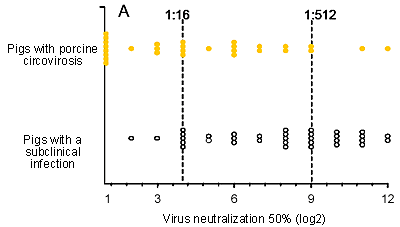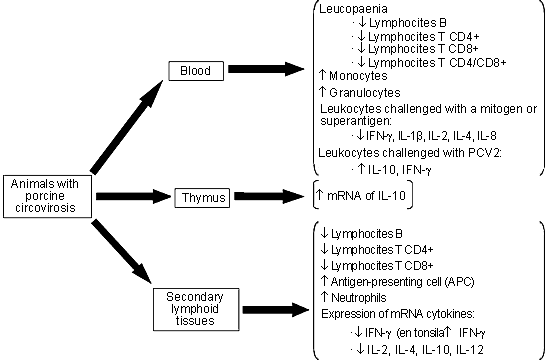Since its first pathological description, PMWS has been considered to be a disease of the pig’s immune system. The histologic lesions which are characteristic of the disease are centred on the lymphoid organs and the disease is mainly found in cells of the monocyte-macrophage line. However, after more than ten years of studies on the disease, it is still not currently known how the interaction is established between the virus and the immune system in the initial stage of the infection or how this interaction evolves towards PMWS or towards a subclinical infection. Curiously, the mechanism by which the lymphocitary depletion is generated in lymphoid organs in association with the PCV2 infection has also not been established. This is why the most relevant current knowledge on the immune response to PCV2 is summarized in this section. On the other hand, information on the immune response generated by PCV2 vaccination is now beginning to become available, and this will be briefly commented on in this article.
The experimental infections with PCV2 have demonstrated that pigs generate an antibody response to the virus which begins between ten and twenty-one days post-infection. These antibodies generated by the infection tend to last for months, and although there are no long term studies available, at least it has been confirmed that a group of animals continue to present antibodies against PCV2 between 14 and 18 weeks post-infection. In a way it is thought that colostral humoral immunity is, at least partially, protective. This is based on:
1. the practical inexistence of descriptions of PMWS in animals younger than four weeks old (age at which pigs generally present a high antibody titer against the virus);
2. the generation of an exclusively subclinical infection when the animals are infected in the presence of high titers of seric antibodies;
3. pigs that are not affected by the disease tend to have a quantity of sero-neutralizing (and also total) antibodies against PCV2, which is significantly greater than those that cause disease (Fig. 1).
Figure 1. Distribution of the titers of viral neutralization to 50% in animals with porcine circovirosis (yellow circles) and animals with a subclinical infection by PCV2 (empty circles). Note that the majority of the animals with the disease are subclinically infected with PCV2 and they dominate the centre and the right (medium and high quantity of neutralizing antibodies). The dotted vertical lines mark the value of the titers of neutralizing antibodies of 1/16 and 1/512. Adapted from Fort et al., 2007


This last point is relevant, given that one of the reasons why it is believed that vaccination products work very efficiently against PCV2 (a subject that will be dealt with in the last article of this series) is the fact that they are capable of generating an important neutralizing response from the antibodies. From the serologic point of view we are presented with the diagnostic problem where in order to be able to see these differences between healthy animals and animals with the disease it is necessary to carry out studies with a wide range of serums (case and control studies). This may be of great scientific value but it is not very useful from a practical point of view; so, serology does not permit an unmistaken diagnosis of PMWS to be established. It has been suggested that a combination of laboratory techniques, including quantitative PCR and the viral neutralization test, could be useful for diagnosis. However, the economic cost of these two combined techniques would be extremely high and would not noticeably improve the diagnosis based on histopathologic studies and studies on the detection of PCV2 in lymphoid tissues.
Currently, the mechanisms of cellular immunity which are generated in animals that are infected with PCV2 and that either develop or do not develop PMWS are largely unknown. However, it is known that pigs affected by PMWS suffer noticeable changes to immune system cell subpopulations and cytokine imbalance (Fig. 2). It has been suggested that the persistence of the virus in dendritic cells could provoke an alteration to the competence of the immune system because the capability of these cells to recognise the “danger signs” of the pathogens is compromised. In other words, PCV2 would harm the maturing factor of the dendritic cells, thus stopping the development of immune responses that are efficient against other pathogens and probably also against PCV2 itself. The knowledge about the possible effect of vaccination against PCV2 on the cellular immune response is currently minimal. However, preliminary data on PCV2 vaccination in sows indicate that in the colostrum there exists a transfer of antigen-specific leukocytes against the virus. It is probable that in the near future there will be important scientific information on the immune response to PCV2 in vaccinated pigs compared to non-vaccinated pigs.
Figure 2. Picture-summary of the alterations of the cellular subpopulations in blood, thymus and secondary lymphoid organs (tonsils, lymph/lymphatic nodes and spleen) which occur in cases of porcine circovirosis.

Therefore, based on the available results of humoral and cellular immunity, it is logical to think that animals affected by PMWS will present acquired immunodeficiency syndrome. However, in this immunity context the “multifactorial” principle which characterizes this disease should not be forgotten. On one side there are factors that are directly associated to immune system itself, but other matters should not be forgotten such as the genetics of the guest and the interaction with other triggering factors (whose mechanisms are also unknown). All of these are aspects which certainly modulate the immune response of pigs infected with PCV2, whether it is by porcine circovirus or by subclinical infection.


